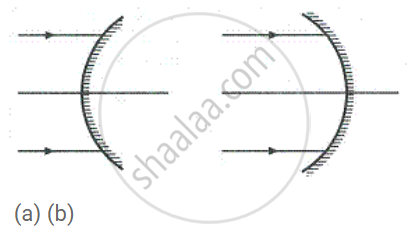Advertisements
Advertisements
Question
State the number of images of an object placed between two mirrors, formed in each case when mirrors are inclined to each other at (a) 90°, and (b) 60°.
Solution
(a) Angle between the mirrors, θ = 90o
Now, n = 360o / θo = 360o / 90o = 4, which is even.
Hence number of images formed will be (n-1); i.e., 4 - 1 = 3 images
(b) Angle between the mirrors, θ = 60o
Now, n = 360o / θo = 360o / 60o = 6, which is even.
Hence number of images formed will be (n-1); i.e., 6-1 = 5 images
APPEARS IN
RELATED QUESTIONS
What happens when a ray of light falls normally (or perpendiculary) on the surface of a plane mirror?
The shiny outer surface of a hollow sphere of aluminium of radius 50 cm is to be used as a mirror:
Which type of spherical mirror will it provide?
A diverging lens is used in:
(a) a magnifying glass
(b) a car to see objects on rear side
(c) spectacles for the correction of short sight
(d) a simple camera
Explain the following term:
Incident ray
Draw diagram/diagrams to show them.
In each case (a) and (b), draw reflected rays for the given incident rays and mark focus by the symbol F.

Name the kind of mirror used to obtain:
A virtual and enlarged image
Which mirror will you prefer to use as a rear view mirror in a car : plane mirror or convex mirror? Give one reason.
A point light source is kept in front of a convex mirror at a distance of 40 cm. The focal length of the mirror is 40 cm. Find the position of image.
Size of image of an object by a mirror having a focal length of 20 cm is observed to be reduced to 1/3rd of its size. At what distance the object has been placed from the mirror? What is the nature of the image and the mirror?
